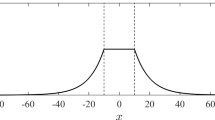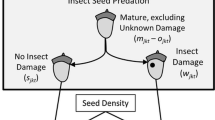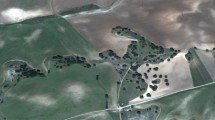Summary
A simple model is presented describing the interaction between weather conditions, seed production of a longlived herb, Vincetoxicum hirundinaria (Asclepiadaceae), and abundance of a predispersal seed predator, Euphranta connexa (Diptera, Tephritidae). The model is used to investigate the role of weather-induced fluctuations in seed set on the interaction between plant and seed predator and the resulting longterm production of seeds escaping predispersal seed predation.
As weather variability increases Euphranta populations become less effective in tracking their food resources, leading to increased longterm production of dispersing seeds. Occasional years of crop failure due to drought stress may thus in the long run be of benefit to the plant.
Similar content being viewed by others
References
Andrewartha HG, Birch LC (1954) The distribution and abundance of animals. The University of Chicago Press, Chicago London, p 782
Boer PJ den (1968) Spreading of risk and stabilization of animal numbers. Acta Biotheor 18:165–194
Denno RF (1983) Tracking variable host plants in space and time. In: Denno RF, McClure MS (eds) Variable plants and herbivores in natural and managed systems. Academic Press, New York, pp 291–341
Huffaker CB (1958) Experimental studies on predation: Dispersion factors and predator-prey oscillations. Hilgardia 27:343–383
Janzen DH (1971) Seed predation by animals. Ann Rev Ecol Syst 2:465–492
Kareiva P (1983) Influence of vegetation texture on herbivore populations: Resource concentration and herbivore movement. In: Denno RF, McClure MS (eds). Variable plants and herbivores in natural and managed systems. Academic Press, New York, pp 259–289
Lakhani KH, Dempster JP (1981) Cinnabar moth and its food plant, ragwort: further analysis of a simple interaction model. J Anim Ecol 50:231–249
Price PW (1984) Alternative paradigms in community ecology. In: Price PW, Slobodchikoff CN, Gaud WS (eds) A new ecology. Novel approaches to interactive systems John Wiley & Sons, New York, pp 353–383
Randall MGM (1982) The dynamics of an insect population throughout its altitudinal distribution: Coleophora alticolella (Lepidoptera) in northern England. J Anim Ecol 51:993–1016
Silvertown JW (1980) The evolutionary ecology of mast seeding in trees. Biol J Linn Soc 14:235–250
Solbreck C, Sillén-Tullberg B (1986) Seed production and seed predation in a patchy and time-varying environment. Dynamics of a milkweed — tephritid fly system. Oecologia (Berlin) 71:51–58
Thompson WR (1929) On natural control. Parasitology 21:269–281
Wiens JA (1984) Resource systems, populations, and communities. In: Price PW, Slobodchikoff CN, Gaud WS (eds) A new Ecology. Novel Approaches to interactive system. John Wiley & Sons, New York, pp 397–436
Author information
Authors and Affiliations
Rights and permissions
About this article
Cite this article
Solbreck, C., Sillén-Tullberg, B. The role of variable weather for the dynamics of a seed-seed predator system. Oecologia 71, 59–62 (1986). https://doi.org/10.1007/BF00377321
Received:
Issue Date:
DOI: https://doi.org/10.1007/BF00377321




